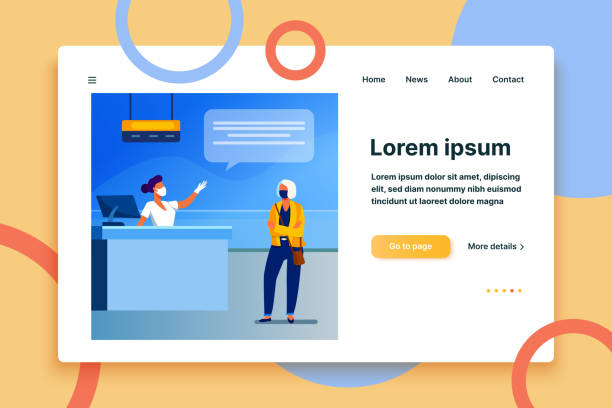Introduction to the World of Responsive Website Design and Its Necessity

In the current digital age, where users access the internet from various devices, the concept of #Responsive_Website_Design or #Responsive_Design has become the backbone of online success.
It’s no longer sufficient to merely have a desktop website and expect success; a significant portion of web traffic now comes from smartphones and tablets.
Therefore, the necessity of responsive website design is felt more than ever.
This approach ensures that your website provides an optimal and consistent user experience, regardless of screen size, resolution, or platform.
From desktop computers to laptops, tablets, and smartphones, your content must be displayed fluidly and pleasantly.
This doesn’t just mean resizing fonts or images, but a complete rearrangement of the layout and web elements for the best user experience on any device.
This evolution not only affects User Experience (UX) but also plays a crucial role in your site’s ranking in search engines.
Search engines like Google prioritize responsive websites, and this is a significant factor for SEO.
In this comprehensive article, we will delve into all aspects of responsive website design, from theoretical foundations to practical implementation and forthcoming challenges, offering an expert and guiding perspective.
This approach prepares your website for the future.
Does your current website showcase your brand’s credibility as it should? Or does it drive away potential customers?
Rasawweb, with years of experience in professional corporate website design, is your comprehensive solution.
✅ A modern, beautiful website aligned with your brand’s identity
✅ Significant increase in lead generation and new customer acquisition
⚡ Contact Rasawweb now for a free consultation on corporate website design!
Fundamental Principles of Responsive Design in Web

To deeply understand responsive website design, it’s essential to become familiar with its three main pillars: Fluid Grids, Flexible Images, and Media Queries.
Fluid grids mean that instead of using fixed pixel units, relative units like percentages are used to define element widths.
This causes the website layout to automatically expand or contract with changes in screen size, filling the available space optimally.
For instance, a column that occupies 50% of the screen width on a desktop will maintain the same proportion on a mobile device.
Flexible images follow the same logic; by using properties like max-width: 100% in CSS, it’s ensured that images never exceed the width of their parent element and scale down or up proportionally to the available space, without losing quality or disrupting the layout.
Media queries are perhaps the most powerful tool in the responsive design toolbox.
This CSS3 capability allows you to apply a set of styles only if specific conditions (such as screen width, device orientation, or resolution) are met.
For example, you can define that on screens smaller than 768 pixels, the navigation menu transforms into a hamburger icon, and on larger screens, it displays in full.
This enables the user experience to be optimized for each device, and content to be presented in a logical and accessible manner.
Understanding and correctly implementing these principles is a fundamental step towards creating a truly effective responsive website design and avoids questionable and complex content.
These aspects constitute the specialized and educational part of this field.
Advantages of Responsive Design and Its Impact on Business

Investing in responsive website design is not just a technical choice, but a strategic decision for business growth.
One of its most important advantages is improved User Experience (UX).
A site that displays well on all devices and performs smoothly keeps users satisfied and increases their likelihood of returning.
This customer satisfaction directly impacts the Conversion Rate; the easier users can access the information they need or make a purchase, the greater the likelihood of your business’s success.
Search Engine Optimization (SEO) is another advantage.
Google has officially announced that it ranks mobile-friendly websites higher in mobile search results.
Having a single, responsive version also simplifies SEO management because there’s no need to manage two separate versions (one for desktop and one for mobile).
This significantly helps prevent duplicate content issues and improves domain authority.
Finally, reduced maintenance and development costs is an analytical and important aspect.
Instead of building and maintaining multiple separate sites or templates for different devices, responsive website design means only one codebase, saving time and costs in development and maintenance.
This allows you to focus your resources on improving one platform instead of managing multiple ones, facilitating a rapid response to market needs.
The table below summarizes the strengths of responsive design:
| Advantage | Description | Impact on Business |
|---|---|---|
| Improved User Experience | Compatibility with any screen size | Increased customer satisfaction and engagement |
| SEO Friendliness | Prioritization by search engines | Higher ranking in search results |
| Reduced Maintenance Costs | One codebase for all devices | Savings in time and resources |
| Increased Conversion Rate | Easy access and smooth navigation | More sales and customer acquisition |
| Future-Proofing | Compatibility with new devices | Maintaining competitiveness in the market |
Popular Tools and Frameworks for Responsive Design

For efficient implementation of responsive website design, there are numerous tools and frameworks that can simplify and accelerate the development process.
One of the most well-known and widely used is Bootstrap.
Bootstrap is a CSS, HTML, and JS framework that includes ready-made design templates for typography, forms, buttons, tables, navigations, and other user interface components.
Using its 12-column Grid System and predefined classes, developers can quickly and easily create responsive layouts.
Learning Bootstrap is highly beneficial for those seeking practical guidance on responsive website design.
Another framework is Foundation, developed by ZURB, which also provides a powerful set of tools for building responsive websites and web applications.
Compared to Bootstrap, Foundation offers greater flexibility and customization, and is often preferred by developers seeking more precise control over design details.
In addition to comprehensive frameworks, native CSS technologies like CSS Grid and Flexbox also play a very important role in responsive website design.
Flexbox is ideal for one-dimensional layouts (a single row or column) and performs very powerfully for distributing space between items and aligning them.
In contrast, CSS Grid is designed for two-dimensional layouts (both rows and columns) and allows for easier creation of more complex layouts and full-page grids.
Combining these technologies with media queries gives developers unparalleled control over how content is displayed on different devices, providing a flawless user experience.
This section includes specialized and educational content that provides practical guidance.
Does your current e-commerce website design not achieve the sales you expect?
Rasawweb specializes in professional e-commerce website design!
✅ An attractive and user-friendly site aimed at increasing sales
✅ High speed and security for an ideal shopping experience⚡ Get a free online store design consultation with Rasawweb!
Mobile-First Approach: The Foundation of Modern Responsive Website Design

The Mobile-First approach is not just a trend, but a design philosophy that has become the backbone of responsive website design in the current era.
This approach means starting the design and development process from the smallest screen (typically mobile) and then scaling it up towards larger screens (tablet and desktop).
The main reason for this choice is the inherent limitations of mobile devices, such as smaller screen size, lower internet speed, and touch interaction.
By designing for mobile first, you are forced to focus on the most important content and functionalities, leading to a more minimalist, efficient, and ultimately better user interface.
When designing for mobile, you have limited space, so you must make tough decisions about what is truly essential.
This process ensures that unnecessary content is removed and the core user experience is preserved.
Then, as the screen size increases, you can progressively add more details, additional functionalities, and richer visual elements.
This method contrasts with the ‘desktop-first’ approach, where a website is first designed for desktop and then ‘shrunk’ for mobile, often leading to forced content removal or an inappropriate user experience on smaller devices.
The mobile-first approach also has significant SEO benefits, as Google uses mobile-first indexing, meaning it prioritizes the mobile version of your site for ranking and indexing.
Effectively implementing this approach helps you create a responsive website design that is not only technically optimized but also prioritizes user needs, regardless of the device they use.
This is practical and educational guidance for achieving the highest level of quality in web design.
Testing and Debugging Responsive Websites

Responsive website design is not limited to the coding phase; one of the vital and often overlooked stages is comprehensive testing and debugging.
Given the countless variations of devices, screen sizes, and operating systems, ensuring proper functioning and flawless display of the website under all conditions is complex but essential.
For testing, you can use browser tools.
Browser Developer Tools like Chrome DevTools, Firefox Developer Tools, or Safari Web Inspector provide the ability to simulate various devices with different sizes and orientations (horizontal and vertical).
These tools allow you to quickly see how your website appears at different dimensions and identify potential issues in layout, fonts, or images.
Furthermore, testing on real devices is extremely important.
Although simulators are useful, they cannot reproduce all the details of the user experience on real devices (such as touch performance, processing speed, and specific browser rendering).
Therefore, it is recommended to test your website on at least a few popular devices (an Android phone, an iPhone, a tablet).
For debugging, look for breakpoints in your design where the layout breaks or elements are not displayed correctly.
These points usually occur at the boundaries of media queries or at specific screen sizes that were not anticipated.
By identifying and resolving these issues, you can create a robust and resilient responsive website design.
Tools like BrowserStack or CrossBrowserTesting also greatly assist in testing on a large number of real devices and browsers virtually.
This stage is expert and explanatory guidance for ensuring the quality of your website.
Common Challenges and Solutions in Responsive Website Design

Although responsive website design has countless advantages, its implementation is not without challenges.
One of the most common challenges is managing images and videos.
High-resolution images can be large in size and severely reduce site loading speed on mobile devices with slow internet.
The solution to this problem is using responsive images that leverage HTML5 features like srcset and sizes for the browser to select the optimal image size based on screen size and device resolution.
Additionally, newer image formats like WebP can help reduce file size.
For videos, using the <video> tag with max-width: 100% or using responsive embeds from services like YouTube or Vimeo are appropriate solutions.
Another challenge is performance issues.
Responsive websites, especially if not properly optimized, may perform slowly on less powerful devices.
Optimizing CSS and JavaScript, file compression, caching, and using a CDN (Content Delivery Network) can all help improve loading speed.
Attention to these aspects is vital in responsive website design.
Navigation complexity can also be an issue.
Extensive desktop menus might occupy too much space on mobile.
Popular solutions include Hamburger Menus, Off-Canvas Menus, or Hidden Navigation that appear when needed.
This section addresses questionable and analytical content and provides guidance for overcoming these challenges.
The table below shows some of the most common problems and their solutions:
| Challenge | Description | Solution |
|---|---|---|
| Heavy Images | Reduced loading speed on mobile | Responsive images (srcset/sizes), WebP format |
| Poor Performance | Slow site on less powerful devices | CSS/JS compression, Caching, CDN |
| Complex Navigation | Limited space on mobile for menus | Hamburger menu, Off-canvas menu |
| Inappropriate Forms | Difficulty filling forms on mobile | Designing simple forms with large fields |
| Touch User Experience | Problem with small clickable elements | Increasing touch target size and larger UI elements |
The Future of Web Design and the Role of Responsive Design

The future of web design is heavily intertwined with the concept of responsive website design.
With the advent of new devices such as smartwatches, virtual reality (VR), augmented reality (AR), and even smart vehicles, all of which have the potential to display web content, the need for flexible design is felt more than ever.
Responsive design is no longer just about responding to different screen sizes, but about responding to different types of inputs (touch, voice, gesture), different environments, and even changing user needs.
Technologies like Container Queries (recently introduced in CSS, allowing response to parent container size instead of viewport size) and more advanced Media Features in media queries open up new horizons in responsive website design.
These allow developers to have more precise control over how elements are displayed within their context, and not just based on the overall page size.
Furthermore, Artificial Intelligence and Machine Learning are expected to play an increasing role in automating and optimizing the responsive design process.
These technologies can dynamically adjust layouts and styles by analyzing user and device behavior to provide the best possible experience.
Responsive website design is moving towards Adaptive Design, which responds not only to screen size but also to device capabilities and user preferences.
This approach prepares websites for future unknowns and offers a novel and engaging outlook on the future of the web.
Are you missing out on business opportunities due to an outdated website? With Rasawweb, permanently solve the problem of not attracting potential customers through your website!
✅ Attract more high-quality leads
✅ Increase brand credibility in the eyes of customers
⚡ Get a free corporate website design consultation
Case Study: Successful Examples of Responsive Website Design

To better understand the effectiveness and successful implementation of responsive website design, examining real-world examples can be very instructive.
Many global brands and major news websites utilize this approach to provide a seamless user experience to their broad audiences.
Major news websites like The New York Times or BBC News are prominent examples of responsive design.
These sites must make a vast amount of text, image, and video content available to users without compromising its layout and readability on different devices.
Their responsive design ensures that headlines, articles, and photo galleries are displayed legibly and navigably on mobile, tablet, and desktop, optimizing the user experience for every screen size.
Online retail brands like Amazon or Zara also owe their success to responsive website design.
On an e-commerce site, the ability to browse products, add to cart, and complete the checkout process must be seamless on any device.
By using responsive design, these sites ensure that buttons are large enough, product images are clear, and store navigation is intuitive even on the smallest screens.
This significantly helps increase conversion rates and reduce shopping cart abandonment rates.
Banks and financial institutions have also moved towards responsive website design so that customers can easily access their accounts and perform transactions via mobile and tablet.
These examples demonstrate that with a strong and analytical responsive design, various business goals can be achieved, and customer satisfaction can be ensured on any platform.
These examples illustrate the engaging and analytical aspects of practical applications of responsive website design.
The Importance of Content in Responsive Design

Alongside technical aspects, content plays a pivotal role in the success of responsive website design.
A responsive site with poor or inappropriate content will still not provide a good user experience.
Content must not only be optimized for search engines but also structured in a way that it is readable, understandable, and engaging on any screen size.
For example, on mobile devices with small screens, long texts and dense paragraphs can appear tiresome.
Therefore, using shorter sentences, smaller paragraphs, clear headings, and bulleted lists helps improve readability.
Also, sufficient use of Whitespace prevents visual clutter and helps users focus on the main content.
Another important aspect is Responsive Content Strategy.
This means planning how content will be displayed at different sizes.
It might be necessary to remove some heavier graphical elements or less important information in mobile versions to increase loading speed.
Or optimize the display of images and galleries for touch experience.
Interactive content, such as forms or maps, must also be designed to be easily usable on smaller devices.
Buttons should be large enough to be easily touched, and form fields should be simple and not require zooming.
This comprehensive approach to content complements the technical aspects of responsive website design and ensures that your website is not only visually responsive but also has its content optimized for consumption on any device.
This section includes a combination of educational and explanatory content.
Frequently Asked Questions
| Question | Answer |
|---|---|
| What is Responsive Web Design? | It’s an approach that ensures your website’s layout displays well on any device (such as mobile, tablet, and desktop) and adapts to the user’s screen size. |
| Why is responsive design important? | Improved user experience across different devices, increased traffic and conversion rates, better ranking in search engines (SEO), and reduced need for developing separate mobile versions. |
| How is responsive design implemented? | By using CSS media queries to apply different styles based on device characteristics (like screen width), using Fluid Grids, and Flexible Images. |
| What are the main technologies used in responsive design? | HTML5, CSS3 (especially Media Queries), and JavaScript. |
| What are the main advantages of responsive design? | Seamless user experience across different devices, easier website maintenance, better SEO (because Google prefers responsive sites), and cost and time savings compared to developing a mobile application or a separate site. |
And other advertising services of Rasawweb Advertising Agency
Smart Content Strategy: Revolutionize website traffic with marketing automation.
Smart Content Strategy: Revolutionize user engagement with precise audience targeting.
Smart Advertorials: An innovative service to increase customer acquisition through custom programming.
Smart Sales Automation: An innovative service to increase sales through marketing automation.
Smart Data Analysis: Designed for businesses seeking to improve SEO ranking through marketing automation.
And over a hundred other services in the fields of online advertising, advertising consultation, and organizational solutions
Internet Advertising | Advertising Strategy | Advertorial
Resources
Principles of Responsive DesignWeb Development Trends in 2023Best Responsive CSS FrameworksHistory of Web Design
📍 Ready to elevate your business in the digital world? Rasawweb Afarin Digital Marketing Agency, with years of experience and a specialized team, offers comprehensive and results-oriented solutions for your brand’s growth and visibility. From responsive website design and SEO to social media management and targeted advertising campaigns, we are with you every step of the way to turn your digital dreams into reality. With Rasawweb Afarin, your business’s bright future begins today.
📍 Tehran, Mirdamad Street, next to Central Bank, Southern Kazeroun Alley, Ramin Alley, No. 6




